Aphid activity update
Canola and lupin aphids
- Canola aphid locations: Ogilvie to Esperance.
- Lupin aphids: Dandaragan
There have been widespread reports of cabbage aphid infestations in canola crops at Yarragadee, Yandanooka, Mingenew, West Morawa, Bodallin, Wongan Hills, Cunderdin, Meckering, Tammin and Howick. These crops were moisture stressed.
Turnip aphids have been found in moisture stressed canola crops near Bodallin and canola near Howick. Agworld users have also reported turnip aphids in canola near Wongan Hills.
Cabbage and turnip aphids can cause significant yield loss to canola in spring, especially in areas where plants are already moisture stressed and aborting flowers or pods given the plants limitations. Aphid infestations in moisture-stressed canola crops that are in the fully podded stage, can result in lower seed production or development of shriveled seed due to aphids preventing seed fill.
Research Scientist Andrew Philips (DPIRD) has observed green peach aphids (GPA) on canola near Moonyoonooka. The affected crop had been sprayed a few days prior with chlorpyrifos and alphacypermethrin. Agworld users have also reported finding GPA in canola near Geraldton.
GPA typically do not pose a significant late-season threat unless they congregate in thick clusters on pods.
Chris Wilkins (Vision Agribusiness Services) reports finding high numbers of GPA causing stress to branch terminals in a lupin crop at Dandaragan. Many of the aphids were turning orange, which is a common occurrence in green peach aphids, especially when they are infected with an aphid fungus. The aphid clusters were causing further stress to an already moisture-stressed crop.
To read about prior canola aphid activity this season refer to DPIRD’s 2023 PestFacts WA Issue 14 article cabbage aphids have been increasing in canola and Issue 10 turnip yellows virus detected in flying green peach aphids and in canola.
For more information on canola aphids refer to:
- DPIRD’s aphid management in canola crops page
- DPIRD’s diagnosing canola aphids page
- DPIRD’s 2017 Protecting WA Crops Issue 3 newsletter Aphids – WA’s insect problem children
- GRDC’s aphids in your crops YouTube video.
Cereal aphids
- Cunderdin
- Meckering
- Tammin
- Pingelly
Dan Taylor (DKT Rural Agencies) reports finding oat aphids in barley and wheat crops at Cunderin, Meckering and Tammin. The infested crops were moisture stressed.
Harmohinder Dhammu (DPIRD) recently found high numbers of oat aphids in a wheat trial site at Pingelly, with many tillers having more than 60 aphids.
Growers are advised to inspect their cereal crops for aphids, especially along crop edges where they tend to colonise first and form hotspots.
For more information on cereal aphids, and previously reported cereal aphid activity this season, refer to DPIRD’s diagnosing cereal aphids page and 2023 PestFacts WA Issue 10 article russian wheat aphid.
Management
Seasonal conditions have been conducive to aphid numbers to build up and cause significant stress to already stressed plants. This can seriously reduce yields.
Remember that naturally occurring parasitoids and predators such as hoverflies, wasps, lacewings and ladybird beetles will also increase with warming weather. These predators can keep aphid populations below threshold levels, and unnecessary spraying of 'anti-feed' synthetic pyrethroid sprays will only counteract their benefits. When spraying, consider spray options that are soft (for example pirimicarb) on predators. Growers need to check canola crops for fungal infections and parasitism in aphids before deciding whether to invest in an insecticide spray. For more information, refer to the department’s know what beneficials look like in your crop and Cesar Australia’s beneficial’s chemical toxicity table page.
If more than 20% of canola plants are infested with colonies of cabbage or turnip aphids, control measures should be considered to avoid yield losses. The risk of economic yield losses to aphids is increased if canola crops are already under some degree of moisture stress or experiencing poor finishing rains. If spraying is required, a border spray may suffice for cabbage aphids, which are most commonly found within 20 to 30 metres of the crop edge.
Barley crops are most at risk from corn and oat aphids. This is due to the possibility of downgrading from malt to feed quality, as aphid feeding damage can cause grain shrivelling. If 50% of tillers have 15 or more aphids, then the feeding damage may cause reductions in yields by up to 10%. It may also reduce grain size. Yield loss is greater in crops that had aphid colonisation from early tillering. Russian wheat aphid (RWA) thresholds are dependent on the crop stage, the time until head emergence, predicted yield and cost of spraying. A RWA threshold calculator is available on GRDC’s russian wheat aphid page.
For a list of insecticides registered for use on aphids, see DPIRD’s 2023 winter spring insecticide guide.
More information
For more information contact research scientists Svetlana Micic in Albany on +61 (0)8 9892 8591 or Dusty Severtson in Northam on +61 (0)8 9690 2160.
Article authors: Cindy Webster (DPIRD Narrogin) and Dusty Severtson (DPIRD Northam).


